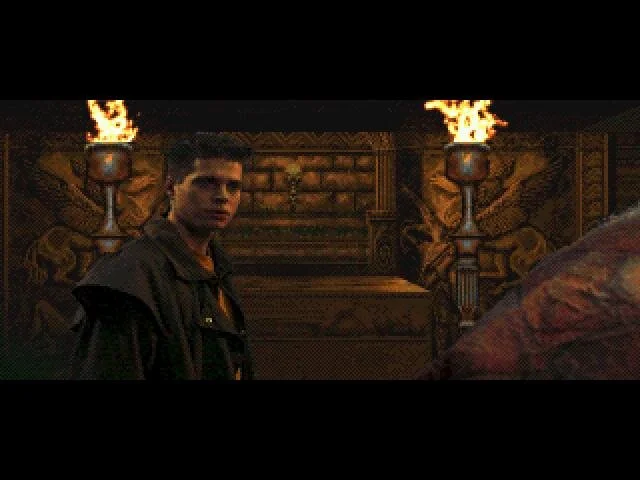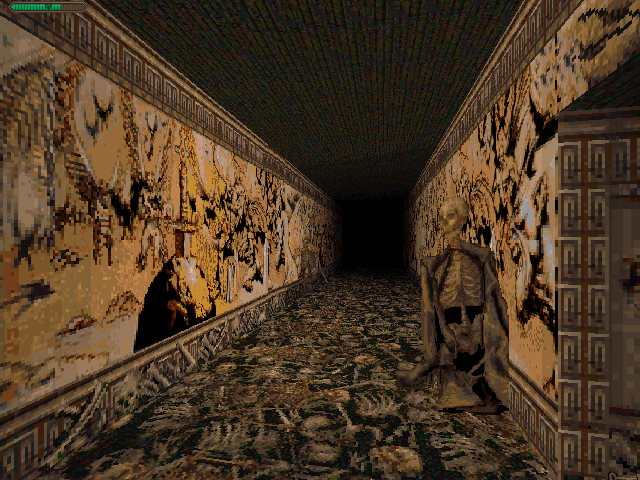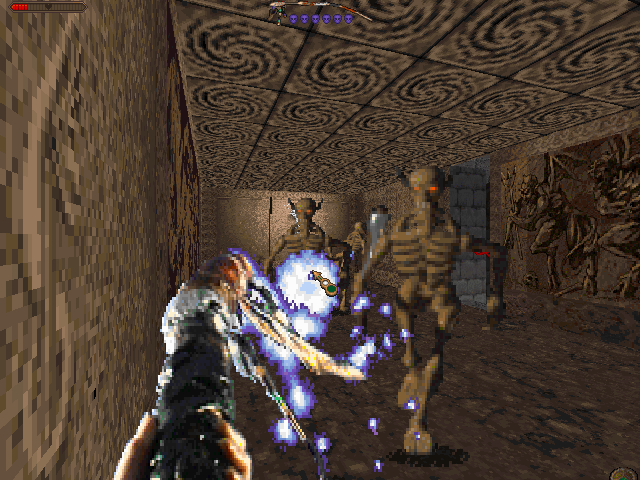Realms of the Haunting Review
First person shooters in the 1990s surged in popularity after the release of Wolfenstein 3D and Doom. A slew of similar titles called “Doom clones” soon flooded the market all the way up to 1998’s Half-Life, the next renaissance in first person gaming. Each clone would take their own stab at the formula set forth by id: segmented levels filled with powerups, reflex-intensive action, and key hunting. All of these games have their appeal and I only reference their Doom clone status to acknowledge their inspiration, not to downplay them. However, the majority of these titles did revolve around the same basic gameplay loop and often had no narrative except for their initial story hook.
Realms of the Haunting, released in 1996 by Gremlin Interactive, broke that cycle by being one of the most original games of the era. It set itself apart from its contemporaries by leaning into the developers’ love for adventure games, providing complex puzzles and an elaborate narrative told through charmingly campy FMV sequences. The acting is surprisingly respectable, which adds needed gravitas to the often flowery dialogue and budget costuming. It’s all par for the course as Realms’ appeal is its full commitment to realizing a world of bizarre genre conventions and art styles all shuffled together.
Your avatar in this strange world is Adam Randall, a young man who’s having vivid dreams of a mysterious house ever since his father’s recent passing. Upon receiving a cryptic clue from someone claiming to know his father, Adam makes his way to the house and finds that the soul of his father is not at rest and has been swept up in a cosmic conflict between various dimensions, many of which can be accessed by the house. A psychic named Rebecca joins Adam and they set out to rescue his father and restore balance to the realms.
Your path through the mansion is fairly convoluted but filled with many shortcuts a la Dark Souls. You’ll have plenty of nice things to look as you go. Medieval Christian imagery is the most prominent motif but there’s certainly a vast spread of influences on display here. Few games rival the breadth of the game's art design which allows it to age well, despite the overall graphical fidelity being low even for a 1996 game. Much attention has been paid to placement, proportion, and color contrast for these truly beautiful areas, from torch-lit caves to steampunk puzzle rooms to heavenly vistas.
Gameplay primarily consists of first-person shooting and puzzle solving. The default controls require the arrow keys to move but if you download the patch at the end of the review*, you can use the WASD keys to move. I never could figure out how to enable mouse look without clicking both mouse buttons to toggle it on and off but I’ve noticed other creators’ footage having no problem with this so the truth is out there, you just have to find it. While aiming’s kind of a pain, the shooting itself still feels really good because of the detailed reload animations and thunderous reports of weapons like your shotgun and blunderbuss. Your arsenal also extends to recharging magic wands and other supernatural weaponry which reinforce the feeling that you are becoming more capable and in tune with the mystical undercurrents of the game world.
Enemy design is quite varied and creative. You’ll see your average monsters and demons, but you’ll also encounter Persian looking swordsmen and giant secret-service types with glowing red eyes who fire pistols and fireballs, among other oddities. Somehow they all fit the vibe because you’re at the heart of a dimensional nexus where strange and fascinating creatures could enter at any moment.
The AI for your adversaries is not great, however, as they don’t pursue you through doorways and just slowly advance on you if you are close. The secret service guys and flying demons have projectile attacks that make them a lot more interesting to fight because you must find adequate cover or strafe. From narrow corridors to open arenas, it’s quite satisfying to put down the menagerie of weirdos with your arsenal.
You’ll also fiddle a lot in your inventory combining items to make quest solving weapons or devices, drinking health potions, or reading scrolls and maps to find clues with Rebecca’s help. You can turn easy mode on for puzzles so that your inventory automatically chooses the correct key or quest item for whatever you’re interacting with, which I highly suggest.
I suggest this built-in assistance because the biggest barrier to entry for this title now is likely the same reason it didn’t catch fire when it released: Realms can be a really hard game to figure out. Whether puzzles or navigation, Realms often makes little effort to hold the player’s hand to help them understand the context of how to progress. So many times there was no clear clue that a distant area across the map had opened up because of my actions and that I needed to go there to progress the story. Many puzzles are comically difficult, especially one that requires mixing various potions and instruments together. It feels like trying to solve a Rubix cube while colorblind: there is zero intuition involved as pieces and chemicals arbitrarily combine to make new items that could never thermodynamically result from their constituent parts. Worse yet, the puzzle requires an exact order for these stages of combination or nothing will happen.
It’s also clear by the game’s end that either the budget was either running low as many reviewers have posited, or that the developers were just trying to pad out the length of the game. There are just too many mazes overall, especially in the last half of the game, and some are heinously confusing due to repeated assets. Mazes are really only fun if they feature a gimmick or design choice that you can then base your chosen path on, but here you’re wandering for minutes at a time hoping you understand what the level designers were thinking.
I spent a good deal of this game with a Steam guide open and have zero shame, and neither should you. It’s unfortunate so many of the puzzles and mazes have this egregious quality to them, as a game that focuses so heavily on them should give you more of a fighting chance to figure them out, a la the ole P.D. James’s writing rule that a mystery novel should have enough clues for the reader to suss out the murderer for themselves by the end. As it stands, the game’s shooting and narrative are worth the tribulations of the more devious puzzle designs, so keep pressing on and you’ll find there’s much to enjoy.
So I’ve badmouthed some of the puzzles and navigation and only praised the shooting for the most part, so I’d be remiss if I didn’t explain further why this game kept me playing. Adam’s simply a well-acted, likeable protagonist with clear motivation. He’s believably unsure at first but carries on even when he’s outmatched, preferring to do what’s right over what’s conducive to his survival. His friendship with the ever-smiling Rebecca is genuine and refreshing as its thankfully bereft of forced romantic entanglement. The story is also quite epic as well as you make your world through numerous unique worlds to stop a cataclysmic event, the details of which I’ll save for your own enjoyment.
Now before I leave you, I want to express what’s so especially enticing about this mix of shooting, puzzle solving, and exploration. As you go back and forth across the more conventional manor interiors and start branching out into more and more fantastic other worldly dimensions, you’ll soon establish an internal map in your head and start to feel like the world is justifying its suspension of disbelief by establishing space and function. Living in the space you’re changing with your actions is the great immersive quality of gaming and when games like Arkane’s Prey or Bioshock or Resident Evil 2 Remake let you take up residence there instead of just passing through assets towards arbitrary goals, it automatically grants a level of immersion few highly linear experiences can hope to match. To this day, there are few game worlds as unique as this one, and it’s so worth it to keep pushing on to see all the sights and meet all the fascinating weirdos that crop up in the various dimensions. There are also few other old school PC games that have such an interesting mythology and story and also manage to pull off fun combat so I implore you to answer the call of Adam’s dream and descend into the house of many realms!
*To patch the controls so you can use the WASD keys to move, visit https://steamcommunity.com/app/292390/discussions/0/558754259947925709/
If you’d like to learn a little more about Realms of the Haunting, check out these fascinating articles on the making of the game here:
https://www.gamesradar.com/the-making-of-realms-of-the-haunting-by-the-end-i-was-completing-the-game-in-two-hours-and-30-minutes/
http://www.wizwords.net/realms-of-the-haunting












